Skin Anomalies
Let our Expert Team at Caress help You Improve Your Skin's Appearance with ThermocoagulationImprove Your Skin with Thermocoagulation
Thermocoagulation is a process that will improve your skin’s appearance by reducing or eliminating unwanted skin anomalies. The anomalies we are able to treat are skin tags, cherry angiomas, milia, angiokeratomas, traumatized pores, unwanted piercings, pigmented spots, keratoses and visible facial capillaries.
The procedure in most cases involves inserting a fine probe into the anomaly and releasing a small amount of current; this will dry up the anomaly. Usually a scab will form and after a healing period the skin will rejuvenate itself and improve in appearance. Most clients find the sensation is quite gentle and say they feel it less than an electrolysis treatment.
During a complimentary consultation, we will explain the procedure, examine your skin anomalies and then determine if we can treat you. At that time we will also determine if the anomalies can be improved during one treatment or if repeated treatments are necessary.
See our rates for Skin Anomaly treatments here.
- Skin Tags
- Cherry Angiomas
- Milia
- Angiokeratomas
- Traumatized Pores
- Unwanted Piercings
- Pigmented Spots
- Keratoses
- Visible Facial Capillaries

Description
Skin tags are benign flaps of skin. They are usually darker in colour than your skin and are often found on the neck or underarms. Skin tags can be flat or protruding.
Common Causes
Skin tags are found on women and men of all ages. They are thought to appear on areas of the skin prone to rubbing against skin or clothing. Being overweight also increases the occurrence of skin tags.
Treatment of Skin Tags
A skin tag can be removed permanently in one treatment. If the skin tags are small, many can be removed successfully during one treatment session. When treating small skin tags the technician will touch the tag with the tip of her probe while releasing current, and the skin tag will dry up and fall off on its own immediately or within days.
In the case of larger skin tags, the treatment time will take longer as there is more preparation for the technician. For larger skin tags, the technician will grasp the head of the skin tag with a haemostat; lift the tag up exposing the neck of the skin tag and cut the skin tag off with her probe and current. If the tags are very large only a few may be treated per session.
Post-treatment & Aftercare
Do not rub or scratch the area. A scab will form post treatment. It is important to let the scab heal naturally; this may take a week or two depending on the size of the skin tag that was removed.
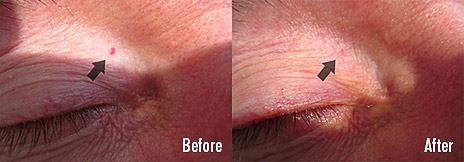
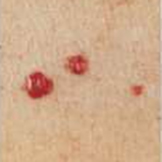
Description
Cherry angiomas are also known as ruby points and Campbell spots. They are the most common vascular lesion. They consist of highly concentrated dilated capillaries and can be flat to the skin or larger and slightly raised. Their appearance is a cherry red to purplish colour.
Common Causes
Cherry angiomas usually appear as we age and typically start out as a small red dot, although they can grow up to a few centimetres in diameter. They are very common and can be found on many areas of the body but are most common on the torso. They usually occur on fair-skinned people and are a hereditary trait.
Treatment of Cherry Angiomas
Small cherry angiomas can usually be cleared with one treatment, although the larger or deeper coloured lesions may require a few sessions. Even if a follow up treatment is necessary, you will still notice an improvement after one treatment; the red spot will lighten to a pinkish colour.
The technician will insert a probe into the anomaly while releasing the current. Smaller anomalies will dry up and disappear. A larger blemish will result in a scab until the skin heals. The procedure is quite quick and many spots can be treated during one session.
Post-treatment & Aftercare
Do not scratch the area and keep it dry. If a scab forms it should be left to fall off on its own. If the anomaly hasn’t disappeared entirely, a follow up treatment can be performed after the skin has completely healed.
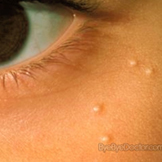 Description
Description
Milia are tiny white bumps on the skin. Milia look like whiteheads and are often found around the eyes and nose. They are keratin filled cysts, which feel like a grain of sand under your skin. They don’t have an opening at the surface so they can’t be extracted like whiteheads.
Common Causes
Milia can be found on babies and people of all ages. They can be a hereditary trait. Some milium will disappear without treatment, and exfoliating can also help. Others are often persistent and need to be extracted by a professional.
Treatment of Milia
Milia are easily removed by thermocoagulation. The technician will insert a probe with current into the milium to soften the debris and then use a lancet to break the skin and extract the milium.
Post-treatment &Aftercare
The area may be a little swollen and red after treatment, depending on how many are extracted and the size of the milium. In some cases a small scab may appear which will heal on its own within days.
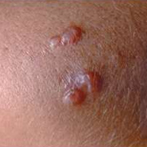 Description
Description
Angiokeratomas are colourless mole-like skin anomalies with the presence of capillaries.
Common Causes
Agiokeratomas are believed to be a hereditary trait.
Treatment of Angiokeratomas
The technician will insert a probe while releasing a steady stream of current to coagulate the angiokeratoma. The anomaly will dry up, resulting in a whitish scab that will darken in colour in a few days. Depending on the size of anomalies, many can be treated in one treatment session. Some angiokeratomas may take repeated treatments to completely disappear.
Post-treatment & Aftercare
The area will be a little irritated post-treatment, and then a small scab will form within a day or two. Keep the area dry and do not touch the area to allow it to heal naturally. The scab will fall off once the underlying skin has rejuvenated. If needed, additional treatments may be performed once the area has completely healed.
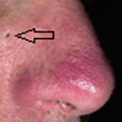 Description
Description
Traumatized pores are visible, open pores.
Common Causes
Traumatized pores are usually self-induced. Continual picking at and unsuccessful extractions of whiteheads or blackheads can cause this problem. Improper technique in trying to free an ingrown hair may cause the pore to become more visible. Debris can also get trapped in the pore exacerbating the problem.
Treatment of Traumatized Pores
The technician will extract any debris from the pore, and then she will insert a probe. Once the probe is at the bottom of the pore, she will release the current while sliding the probe out. The current fuses the skin back together. Depending on the size and depth of the pore, it may take repeated treatments to gradually close the pore.
Post-treatment & Aftercare
The area will be a little inflamed and a small scab will appear post treatment. Let the scab heal naturally. Repeated treatments can be performed after the area has completely healed.
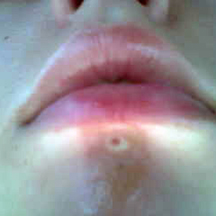 Description
Description
Unwanted piercings are self-explanatory. Most can be closed with the exception of gauged ears.
Common Causes
Piercings may have been performed in an incorrect area, such as too low or too high on the earlobe. Piercings that have been acquired years before may no longer be wanted, including those found in the ears, nose, brows, lips and belly button.
Treatment of Unwanted Piercings
The technician will insert a probe into the hole and release the current while slowly sliding the probe out, fusing the skin together. Usually repeated treatments are required to close the hole completely depending on the side of the hole.
Post-treatment & Aftercare
The hole will be inflamed and tender post-treatment. A scab will appear and will heal on its own within a few weeks. Do not rub or pick at the treatment spot.
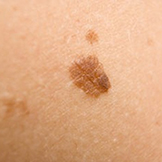 Description
Description
Pigmented spots (also known as age spots or liver spots) are flat brown or black spots. They appear on sun-exposed areas of the body, such as the face, shoulders, back, and back of the hands.
Common Causes
Pigmented spots usually occur as we age and may darken with more sun exposure. Heredity seems to play the most significant role in the development of pigmented spots.
Treatment of Pigmented Spots
The technician gently scrapes off the pigmented spot using a fine probe and current. The sensation will vary depending on the area. The back of hands where the skin is thin will be more sensitive than other body areas. A scab will form and new lighter skin appears once healed.
Post-treatment & Aftercare
Do not rub or scratch the area, and it is essential that you keep the area dry. Avoid strenuous exercise and extreme heat for twenty-four hours post-treatment. A scab will form and you must let it heal naturally; do not remove the scab. The skin will rejuvenate over several weeks, although in some cases a slight lightening of the skin may remain where the pigmented spot was present.

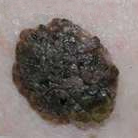
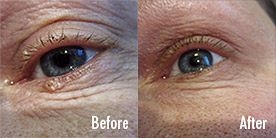

Description
Keratoses, specifically seborrheic or senile keratoses, are common growths most often found in adults over thirty years old. They can be found on almost any area of the body. Keratoses can vary from light-coloured to black, and are flat or raised anomalies with a waxy or wart-like appearance. They are harmless, but we recommend that your keratosis be evaluated by a doctor, as skin cancer can be mistaken for a keratosis. This is especially important if it bleeds, itches, or is irritated or inflamed on a regular basis.
Common Causes
The cause of keratosis is unknown but heredity seems to play a role.
Treatment of Keratosis
The technician will remove the keratosis by lifting it off with a probe and current, followed by cauterization of the surface to seal the skin. Some may regrow after removal, but most do not.
Post Treatment & After Care
The treated area will be raw and a scab will appear a few days later. It is very important to let the scab heal naturally and keep the area dry. The skin will rejuvenate over a several week period. In some cases a slight lightening or darkening of your normal skin colour may remain where the keratosis was present.
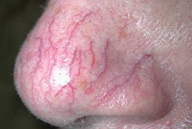
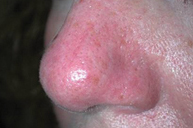
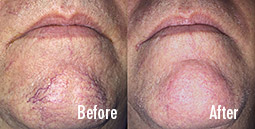
Description
Visible facial capillaries are dilated capillaries that have lost their elasticity and become permanently enlarged. They may form as lines or as dots of redness. The name “spider veins” is given for the spider-like appearance of some—with red centers and little tentacles emerging from the middle.
Common Causes
Visible facial capillaries (blood vessels) often concentrate on the nose, cheeks and chin. The main causes are sun damage, injury, medication and aging. Nearly all fair-skinned people are prone to these unattractive blood vessels, which gradually start appearing in their mid-thirties.
Treatment of Visible Facial Capillaries
Visible facial capillaries are treated by blocking the flow of blood. This is achieved by inserting a probe into the skin and coagulating a small segment of the capillary. Removal of these vessels causes no risk to the health of the skin. When these are treated, new normal-size capillaries grow to efficiently feed the skin.




Post-treatment & Aftercare
Post-treatment the skin will be slightly inflamed for a few hours. Do not rub, exfoliate or have a facial for several days after treatment.
Wait No Longer. Get Started Today.
